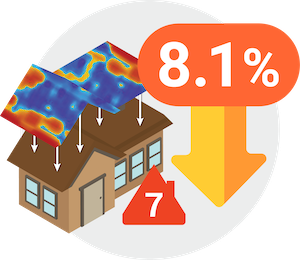MyHEAT
201-1228 Kensington Rd NW
Calgary, AB T2N 3P7
Canada
Case Study: Medicine Hat | Alberta, Canada
Municipal Gas & Electric Utility Compares Heat Loss Map to Home Energy Report with Randomized Controlled Trial
Heat Loss Maps | Marketing
Alberta's 'Gas City' Uses Visual Imagery as a Behavioural Nudge to Motivate Energy-Saving Action

Read 458 words below. Don't have time? Send to your inbox for later.

Great, we’ll send this case study to your email!
Quick Stats
- A randomized controlled trial (RCT) was created with 3 groups of ~4,600 homes to measure impact
- The RCT compared exposure to Heat Loss Maps, Home Energy Reports (HERs) and had a control group.
- There was a 28% increase in applications for weatherization and building envelop upgrades.
- There was a 240% decrease in energy consumption in the Heat Loss group compared to the control group
The Challenge
The City of Medicine Hat approached MyHEAT to explore opportunities to capture more energy savings. Nicknamed ‘The Gas City’, Medicine Hat is located in a politically conservative region with abundant natural gas resources — factors which can typically prevent significant progress on topics like energy efficiency.
The goal was to motivate action through behavioural change and educational channels to drive uptake in weatherization programs and home retrofits, reducing gas consumption and increasing energy savings.
The Approach
The municipally-owned gas and electric utility conducted a randomized controlled trial (RCT) to measure consumption and program uplift amongst homeowners in two groups. The first group, Heat Loss Comparison Group, received MyHEAT’s visual heat loss details, and the second group received standard Home Energy Reports (HER) messaging. We then compared the two groups to a control group that received no treatment-specific messaging.
Each group consisted of approximately 4,600 homes and they were balanced based on consumption, building size, building value, and HEAT Rating. Treatment groups received the following personalized messaging on utility bills during 2018:

Heat Loss Comparison Group
This group received a personalized HEAT Map of their home, and a HEAT Rating comparing their home to their neighbours' and the city average on their utility bills.
Home Energy Report (HER) Group
This group received a graphical comparison of energy usage to similar sized-homes on their utility bills
Control Group
This group received no treatment-specific messaging on utility bills.
The Heat Loss Comparison Group was shown the following Heat Loss Map and HEAT Rating compared their energy usage to similar homes nearby:


The Results
Energy Savings
Academic teams from the University of Ottawa and Carleton University analyzed the findings. When focusing on the energy savings for homes with higher consumption, the pilot found an 8.1% reduction in natural gas consumption per $100 of estimated utility bill savings amongst the homes shown MyHEAT imagery. This is compared to a 1.3% reduction for homes shown the traditional Home Energy Report.


The academic teams discovered that overall during the pilot, customers in the Heat Loss Comparison Group (MyHEAT imagery) saved 2X more energy than customers in the HER Group. Homes in both groups were shown their potential cost savings, and customers with higher money-saving potential achieved larger energy savings.
These results suggest that targeting homes with the largest saving potential could achieve even higher energy savings (this pilot considered all homes, regardless of savings potential).
Program Uplift
Customers in the Heat Loss Comparison Group were more likely to participate in offered incentive programs when compared to the Control Group.

Improve energy efficiency program results with compelling and comparable visual heat loss and solar potential insights, at city-scale.
Need More Proof? Choose Another Case Study.
Heat Loss Maps help Union Gas increase energy efficiency program participation with 7X marketing response.
The “Home Heat Saver” program uses heat loss imagery to drive heat pump rentals, with a 30% increase in web traffic.
Since 2019, the City of Edmonton’s Change for Climate solar program has since 30% annual growth supported by MyHEAT Solar Maps.


